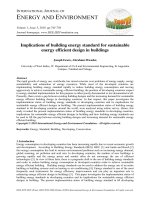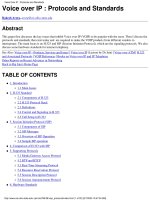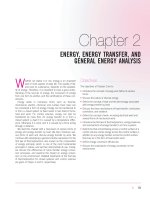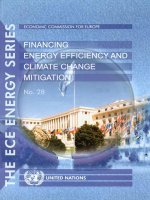Understanding Building Energy Codes and Standards
Bạn đang xem bản rút gọn của tài liệu. Xem và tải ngay bản đầy đủ của tài liệu tại đây (1.1 MB, 14 trang )
PNNL-14235
Understanding Building Energy
Codes and Standards
R. Bartlett
M.A. Halverson
D.L. Shankle
March 2003
Prepared for the U.S. Department of Energy
under Contract DE-AC06-76RL01830
DISCLAIMER
This report was prepared as an account of work sponsored by an agency of
the United States Government. Neither the United States Government nor
any agency thereof, nor Battelle Memorial Institute, nor any of their
employees, makes any warranty, express or implied, or assumes any legal
liability or responsibility for the accuracy, completeness, or usefulness of
any information, apparatus, product, or process disclosed, or process
disclosed, or represents that its use would infringe privately owned rights.
Reference herein to any specific commercial product, process, or service by
trade name, trademark, manufacturer, or otherwise does not necessarily
constitute or imply its endorsement, recommendation, or favoring by the
United States Government or any agency thereof, or Battelle Memorial
Institute. The views and opinions of authors expressed herein do not
necessarily state or reflect those of the United States Government or any
agency thereof.
PACIFIC NORTHEST NATIONAL LABORATORY
operated by
BATTELLE
for the
UNITED STATES DEPARTMENT OF ENERGY
Under Contract DE-AC06-76RL01830
Printed in the United States of America
Available to DOE and DOE contractors from the
Office of Scientific and Technical Information,
P.O. Box 62, Oak Ridge, TN 37831-0062;
ph: (865) 576-8401
fax: (865) 576-5728
email:
Available to the public from the National Technical Information Service,
U.S. Department of Commerce, 5285 Port Royal Rd., Springfield, VA 22161
ph: (800) 553-6847
fax: (703) 605-6900
email:
Online ordering: />
This document was printed on recycled paper. (8/00)
Understanding Building Energy
Codes and Standards
R. Bartlett
M.A. Halverson
D.L. Shankle
March 2003
Prepared for
the U.S. Department of Energy
under Contract DE-AC06-76RL01830
Pacific Northwest National Laboratory
Richland, Washington 99352
Understanding Building Energy Codes
and Standards
The ICC Codes
The International Code
Council publishes a variety of
model codes in addition to the
IECC:
• International
Mechanical Code
• International Plumbing
Code
• International Fire Code
• International Electrical
Code
• International Fuel Gas
Code
• International Private
Sewage Code
• International Property
Maintenance Code
• International Zoning
Code
• International
Residential Code (IRC).
A complete residential
building code,
containing more than
just energy provisions.
Includes the simple,
prescriptive energy
provisions for
residential buildings
from the IECC. (The
IECC includes many
other compliance paths
besides the simple
prescriptive path found
in the IRC.)
• International Building
Code. A complete
building code for
residential and
commercial buildings,
containing more than
just energy provisions.
Energy-efficient buildings offer energy, economic, and environmental benefits.
They reduce energy expenditures and environmental pollutants. They also create
economic opportunities for business and industry by promoting new energyefficient technologies.
Unfortunately, the marketplace does not guarantee energy-efficient design and
construction. Owners of commercial buildings generally pass on energy costs to
consumers or tenants, eliminating any incentive for energy-efficient design and
construction. Homebuyers often are motivated more by up-front costs than
operating costs.
Energy codes and standards play a vital role by setting minimum requirements
for energy-efficient design and construction. They outline uniform requirements
for new buildings as well as additions and renovations.
The Difference Between Energy Codes, Energy
Standards, and the Model Energy Code
Energy codes – specify how buildings must be constructed or perform, and are
written in mandatory, enforceable language. States or local governments adopt
and enforce energy codes for their jurisdictions.
Energy standards – describe how buildings should be constructed to save
energy cost-effectively. They are published by national organizations such as the
American Society of Heating, Refrigerating, and Air-Conditioning Engineers
(ASHRAE). They are not mandatory, but serve as national recommendations,
with some variation for regional climate. States and local governments
frequently use energy standards as the technical basis for developing their energy
codes. Some energy standards are written in mandatory, enforceable language,
making it easy for jurisdictions to incorporate the provisions of the energy
standards directly into their laws or regulations.
The International Code Council (ICC) publishes and maintains the International
Energy Conservation Code (IECC), which is a model energy code that makes
allowances for different climate zones. Because it is written in mandatory,
enforceable language, state and local jurisdictions can easily adopt the model as
their energy code. Before adopting the IECC, state and local governments often
make changes to reflect regional building practices.
Table 1 provides an overview of energy standards and the model energy code.
Table 1. Overview of National Energy Standards and the Model
Energy Code
Title
Type
Sponsoring
Organization(s)
International Energy
Conservation Code
(IECC)
Model
Energy Code
ICC
Applies to
residential and
commercial
buildings.
Written in
mandatory,
enforceable
language.
1998 IECC
2000 IECC
ASHRAE/IESNA/AN
SI Standard 90.1:
Energy-Efficient
Design of New
Buildings Except
Low-Rise Residential
Buildings
Energy
Standard
ASHRAE, together
with the Illuminating
Engineering Society
of North America
(IESNA) and the
American National
Standards Institute
(ANSI)
Applies to all
buildings except
residential
buildings with
three stories or
less.
90.1- 1989
90.1-1999(a)
ASHRAE Standard
90.2 Energy-Efficient
Design of New LowRise Residential
Buildings
Energy
Standard
ASHRAE
Applies to
residential
buildings with
three stories or
less.
90.2-1993
90.2-2001
DOE Monitors the
Model Energy Code
Federal law requires the
U.S. Department of Energy
(DOE) to determine whether
revisions to the residential
portion of the IECC would
improve energy efficiency in
the nation’s residential
buildings and whether
revisions to
ASHRAE/IESNA/ANSI
Standard 90.1 would
improve energy efficiency in
the nation’s commercial
buildings.
When DOE determines that
a revision would improve
energy efficiency, each state
has two years to review the
energy provisions of its
residential or commercial
building code. For
residential buildings, a state
has the option of revising its
residential code to meet or
exceed the residential
portion of the IECC. For
commercial buildings, a
state is required to update
its commercial code to meet
or exceed the provisions of
Standard 90.1.
Description
Commonly
Used
Versions
(a) Written in mandatory, enforceable language
How Are Energy Standards Developed and Revised?
Standards 90.1 and 90.2 are developed and revised through voluntary consensus
and public hearing processes that are critical to widespread support for their
adoption.
Who Is Involved?
ASHRAE works with other standards organizations, such as the IESNA, ANSI,
American Society of Testing and Materials (ASTM), Air Conditioning and
Refrigeration Institute (ARI), and Underwriters Laboratories (UL). The
voluntary consensus process also includes representation from:
• The design community, including architects, lighting, and mechanical
designers;
• Members of the enforcement community, including building code officials,
representatives of code organizations, and state regulatory agencies;
• Building owners and operators;
• Industry and manufacturers;
• Utility companies; and
• Representatives from the Department of Energy, Pacific Northwest National
Lab, energy advocacy groups, and the academic community.
How Does the Process Work?
Standards 90.1 and 90.2 are both on continuous maintenance and are maintained
by separate Standing Standards Project Committees. Committee membership
varies from 10 to 60 voting members. Committee membership includes
representatives from the list above to ensure balance among all interest
categories.
After the committee proposes revisions to the standard, it undergoes public
review and comment. The committee usually incorporates non-substantive
changes into the standard without another review. Substantive changes require
additional public review. Occasionally, mediation is necessary to resolve
differing views.
When a majority of the parties substantially agree (this is known as consensus),
the revised standard is submitted for approval to the ASHRAE Board of
Directors. Those not in agreement with the decision may appeal to the Board. If
an appeal is upheld, further revision, public comment, and resolution occur. If
the Board denies the appeal, publication of the revised standard would then
proceed.
The entire process can take as little as two years or up to 10 years.
What’s the Timing of Revisions to Standards 90.1 and
90.2?
Standards 90.1 and 90.2 are automatically revised and published every three
years. However, anyone may propose a revision at any time. Approved interim
revisions (called addenda) are posted on the ASHRAE website and are included
in the next published version.
Key activities relating to revisions, including responding to public comments,
typically occur during one of ASHRAE’s annual (June) or mid-winter (January)
meetings. Public review of standards commonly occurs two to four months after
one of these meetings.
How Are Model Energy Codes Developed and
Revised?
The most recent model energy codes are the 1998 IECC and the 2000 IECC.
These are developed and published by the International Code Council through an
open public-hearing process. Prior to 1998, the IECC was known as the Council
of American Building Officials Model Energy Code (MEC).
Who Is Involved?
The IECC Code Development Committee typically comprises of seven to 11
individuals appointed by the ICC. Most, but not all, committee members are
code officials. They may or may not be members of the ICC.
How Does the Process Work?
Anyone may suggest a revision to the IECC by requesting a code change
proposal from the committee and preparing a recommended change and
substantiation. The committee publishes proposed changes and distributes them
for review. This occurs about six weeks prior to an open public hearing.
At the public hearing, the committee receives testimony and then votes to
approve, deny, or revise each change. The committee publishes its results.
Those wishing to have a proposed change reconsidered may submit a challenge
to the committee’s recommended action. Proponents and opponents present
additional information at a second public hearing, followed by a vote by the full
ICC membership. This outcome may be appealed to the ICC Board of Directors.
What’s the Timing of the Process?
The IECC is revised on an annual cycle. However, full publication of the
document occurs every third year, with supplements issued in the interim years.
When developing and adopting their own energy codes, states and local
governments typically adopt the full-published IECC. By specifically adopting
the supplements as well, state and local governments ensure that their energy
codes include important additions and clarifications to the IECC.
Adoption of Energy Codes on the State and Local
Level
Before adopting or revising an energy code, states and local governments often
assemble an advisory body comprising representatives of the design, building
construction, and enforcement communities. This body determines which (if
any) energy standards and model energy codes should be adopted. The group
also considers the need to modify energy standards and model energy codes to
account for local preferences and construction practices. The body also may
serve as a source of information during the adoption process.
Overview of the Adoption Process
The adoption process generally includes the following steps:
• Change is initiated by a legislative or regulatory agency with authority to
promulgate energy codes. Interested or affected parties also may initiate
change. An advisory body typically is convened. The proposed energy
code is developed.
• The proposal undergoes a legislative or public review process. Public
review options include publishing a notice in key publications, filing notices
of intent, or holding public hearings. Interested and affected parties are
invited to submit written or oral comments.
• The results of the review process are incorporated into the proposal, and the
final legislation or regulation is prepared for approval.
• The approving authority reviews the legislation or regulation. Revisions
may be submitted to the designated authority for final approval or for filing.
• After being filed or approved, the code is put into effect, usually on some
specified future date. This grace period allows those regulated to become
familiar with any new requirements. The period between adoption and
effective date typically varies from 30 days to six months.
Details of the adoption process vary depending on whether the energy code is
adopted by legislation, regulation, or a local government. Each is discussed
below.
Adoption Through Legislation
State legislation rarely includes the complete text of an energy standard or model
energy code. More commonly, legislation references an energy standard or
model energy code that is already published. The legislation often adds
administrative provisions addressing enforcement, updating, variances, and
authority.
Another common approach is to use legislation to delegate authority to an
agency, council, or committee. The delegated authority is empowered to develop
and adopt regulations governing energy-related aspects of building design and
construction. Such regulations are discussed in the next section.
Some states adopt the administrative provisions of the energy code by legislation
and the technical provisions by regulation, or vice versa.
Adoption Through Regulation
City of Chicago
Adopts a Modified
IECC
In 2001, the City of Chicago
adopted the first building
energy code in Illinois,
which is a home-rule state.
Chicago’s building energy
code, which took effect
September 2002, is a
modified version of the
2000 International Energy
Conservation Code. The
city adopted the code to
help address local issues
such as escalating natural
gas prices, reliability of
power supplies, and noncompliance with the U.S.
Environmental Protection
Agency air quality
regulations. Chicago’s
energy code has paved the
way for other large
jurisdictions in Illinois to
adopt similar codes and has
encouraged a current effort
to pursue adoption of a
statewide energy code.
A key factor in a state’s ability to regulate the energy-related aspects of design
and construction is the extent to which the state has authority over adoption,
administration, implementation, and enforcement of building construction
regulations. In most states, a single state agency has such authority. In some
states, no such authority exists. If multiple state agencies, committees, or
councils are involved, the authority is diluted.
When a state agency, council, or committee has authority to adopt regulations, it
must follow requirements outlined in the legislation that enables development,
revisions, and adoption of the regulations. The technical provisions of the
regulations may be unique to the state, or the regulations may adopt, by
reference, national energy standards or a model energy code. When a state
adopts regulations, it typically includes its own administrative provisions within
the regulations.
Adoption by Local Government
If a state has limited authority to adopt an energy code (a “home rule” state (a)),
units of local government have the option to assume that responsibility. Local
governments also can adopt standards or codes that are more stringent than the
state’s.
A local government’s municipal code typically includes a title or provision
covering building construction, under which energy provisions can be adopted.
Most local governments adopt a model energy code by reference. They apply
administrative provisions from other building construction regulations to
implementation and enforcement of the energy code.
Timing the Adoption and Revision of State and Local
Codes
Most states adopt or revise energy codes in concert with the publication of a new
edition of a national energy standard or model energy code. This may occur
(a) In the energy codes and standards arena, home rule means the state cannot
interfere or control on the local level.
either through a regulatory process or automatically because state regulation or
legislation refers to “the most recent edition.”
Adoption also can be tied to the publication date of an energy standard or model
energy code e.g., “This regulation shall take effect one month from publication of
the adopted model energy code.”
Implementation of Energy Codes on the State and
Local Level
During implementation, the adopting jurisdiction(s) must prepare building
officials to enforce the energy code and prepare the building construction
community to comply with it. It is important for all stakeholders to know that a
new code is coming and understand what is required. Many states or
jurisdictions start this education process several years in advance of an energy
code change—often before adoption itself. The more publicity and training on
the new code, the more it will be accepted and used.
Communication and information exchange should occur:
• Between the code-adopting bodies and code-enforcing bodies;
• Between the code-adopting bodies and the building construction
community;
• Between the code-enforcing bodies and the building construction
community;
• Within the building construction community and code-enforcing bodies.
Training is critical. To be effective, training must cater to the specific needs of
building officials, architects, designers, engineers, manufacturers, builders and
contractors, and building owners. Training for specific stakeholders can be
provided or sponsored by the following:
•
•
•
•
•
•
•
State energy offices and agencies
Universities and community colleges
Professional organizations and societies
Utilities
Trade associations
National or regional code organizations
Others, such as the Southface Energy Institute (www.southface.org) or
product distributors.
The Department of Energy, the ICC, ASHRAE and other codes organizations can
supply tools and materials to make implementation and training easier for states
and local jurisdictions.
Enforcement of Energy Codes on the State and
Local Level
Enforcement ensures compliance with an energy code and is critical to securing
energy savings. Enforcement strategies vary according to a state or local
government’s regulatory authority, resources, and manpower. Enforcement can
include all or some of the following activities:
•
•
•
•
•
•
•
Review of plans
Review of products, materials, and equipment specifications
Review of tests, certification reports, and product listings
Review of supporting calculations
Inspection of the building and its systems during construction
Evaluation of materials substituted in the field
Inspection immediately prior to occupancy
Sometimes a state or local government has no enforcement authority. The courts
then address enforcement, if and when legal action is sought by a building owner
against a designer or contractor.
State Enforcement
State enforcement is a common approach in smaller states, in rural jurisdictions
that have no code officials, and for state-owned or financed construction.
Enforcement by a single state agency usually is more uniform than enforcement
conducted by several local agencies. Plan review is generally performed by one
office. Although there may be numerous state field inspectors, they are bound
under one organization. This arrangement benefits the building construction
community by offering a single point of contact. However, if state resources are
limited, plan reviews and construction inspections may not be performed as
thoroughly as warranted.
Local Enforcement
Local enforcement agencies are closer to the construction site and in more direct
contact with the design and construction community. This offers the potential for
more regular enforcement during design and construction.
However, local jurisdictions may lack sufficient resources to support
enforcement. Because jurisdictions vary, local enforcement may lead to some
noncompliance across a state. Compliance is enhanced when a state code agency
actively supports local governments in their efforts to enforce the state code.
Some states allow local jurisdictions to petition to conduct enforcement activities
that are usually the responsibility of the state. This strategy offers the advantages
associated with state enforcement, recognizes those local governments with
equivalent enforcement capabilities, and helps ensure comparable levels of
compliance. Continued state oversight is necessary to ensure a consistent level
of enforcement by local jurisdictions. A hybrid approach might involve the state
conducting the plan review, and the local authority conducting the construction
inspection.
Voluntary Energy-Efficiency Programs
Voluntary programs encourage a level of energy efficiency above code. They
can help motivate consumers to recognize the value of energy efficiency.
Examples include:
• Home energy rating systems. Also known as HERS, these compare the
energy efficiency of a home to a computer-simulated reference house. The
rating involves analysis of the home’s construction plans and at least one
on-site inspection. This information is used to estimate the home’s annual
energy costs and give the home a rating between 0 and 100. The higher the
score, the more efficient the home.
• ENERGY STAR®. The U.S. Environmental Protection Agency outlines
criteria for ENERGY STAR certification of homes and commercial buildings.
ENERGY STAR homes are typically 30 percent more energy efficient than
average minimum energy codes. For more information, go to
www.energystar.gov.
• Utility, government, and other programs. Utilities, state and local
governments, and other organizations often sponsor programs that qualify
buildings based on certain standards. Examples include Good Cents and the
U.S. Green Building Council’s Leadership in Energy & Environmental
Design (LEED).
DOE Support
The Department of Energy’s Building Energy Codes Program (BECP) supports
states and local governments in their efforts to implement and enforce building
energy codes. This support includes:
• Developing and distributing easy-to-use compliance tools and materials;
• Providing financial and technical assistance to help adopt, implement, and
enforce building energy codes;
• Participating in the development of model energy codes and energy
standards; and
• Providing information on compliance products and training, and energy
code-related news.
For more information on BECP products and services, visit the BECP website at
www.energycodes.gov.
Standards Organizations and Code Organizations
American Society of Heating, Refrigerating, and AirConditioning Engineers (ASHRAE)
1791 Tullie Circle NE
Atlanta, GA 30329
(404) 636-8400
www.ashrae.org
Building Officials and Code Administrators International
(BOCA)
4051 West Flossmoor Road
Country Club Hills, IL 60478-5795
(800) 214-4321
www.bocai.org
International Code Council (ICC)
5203 Leesburg Pike, Suite 708
Falls Church, VA 22041
(703) 931-4533
www.intlcode.org
International Conference of Building Officials (ICBO)
5360 South Workman Mill Road
Whittier, CA 90601-2298
(562) 699-0541 or (800) 284-4406
www.icbo.org
Southern Building Code Congress International (SBCCI)
900 Montclair Road
Birmingham, AL 35213-1206
(205) 591-1853 or (888) 44-SBCCI
www.sbcci.org
Building Energy Codes Program
U.S. Department of Energy
www.energycodes.gov









